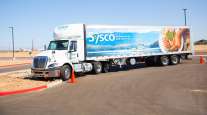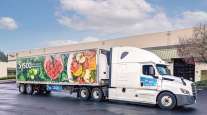Analysts Expect Government to Approve Sysco’s $3.5 Bln. Purchase of U.S. Foods
This story appears in the Jan. 13 print edition of Transport Topics.
Sysco Corp.’s planned acquisition of its largest competitor, U.S. Foods, is likely to be approved by federal regulators and could spur competition among food-service distributors, a prominent food industry consultant said.
William Hale of The Hale Group said in an interview with Transport Topics the move is a reflection of market forces in a business that has been slow to recover from the recession and where restaurants face increased competition from grocery stores.
“When things like this happen, there’s a ripple effect,” Hale said. “We will see other national competitors emerge, and we will see new entrants and new business models. It’s not a static picture.”
The Hale Group, a consulting firm in Danvers, Mass., has worked closely with the International Foodservice Manufacturers Association to benchmark the operations of food distributors.
The $3.5 billion deal, announced in December, remains subject to a review by the Federal Trade Commission and the U.S. Department of Justice. The agencies can block deals if they determine they would “substantially lessen competition.”
Sysco and U.S. Foods are the largest of about 2,500 companies that offer food and cooking supplies to restaurants, schools, hospitals and other eating establishments. The companies have combined revenue of $66 billion and rank No. 3 and No. 5, respectively, on the Transport Topics Top 100 list of the largest private carriers in the United States, Canada and Mexico. They have a combined fleet of more than 13,300 tractors and 16,400 trailers.
Like Hale, John Ivankoe, a stock analyst for J.P. Morgan, said he does not believe the deal will hurt competition.
“Even with a 25%-plus combined market share post-merger, Sysco will still be competing in a highly fragmented and price competitive market,” Ivankoe said in a note to investors.
However, he also said the deal could lead to a loss of some customers, and there could be problems with integrating two different computer systems.
A spokesman for Sysco said last week it was “too soon” to comment on the status of the government’s review. Officials have said the companies will operate separately until the deal closes, which they expect during the second quarter.
Sysco also declined comment on recent statements by the Teamsters union, which called for meetings with management to discuss the effect of the deal on truck drivers and workers at distribution facilities.
The Teamsters represent more than 7,000 workers at Sysco and more than 4,000 at U.S. Foods with more than 100 contracts across both companies, many of which expire over the next year.
Though Hale expects the deal to proceed, he said the government could require some facilities to be sold to preserve competition in certain markets.
He said restaurants “took a major hit” in the recession, which led to “negative growth” in sales for the first time since the food-service distribution business began to emerge in the late 1950s.
“It’s not surprising at this stage in the industry’s development to see consolidation,” Hale said.
He expects other companies, such as Performance Food Group and Reinhart FoodService, to continue making acquisitions and some regional players, such as Gordon Food Service, to become more of a national provider.
Such companies are known in the industry as broadline distributors because they sell to a broad range of customers, in contrast to system distributors that sell to specific restaurant chain operators.
PFG ranks No. 15 on private TT100. Reinhart is a unit of Reyes Holdings, which ranks No. 10 on the list, and Gordon ranks No. 22.
Over the past decade, Hale said, the 10 largest broadline distributors have gained almost 20 percentage points in market share and accounted for more than half of an estimated $185.8 billion in total sales by food-service distribution companies in 2013.
Hale said the combined Sysco-U.S. Foods would control about 35% of the market and “will require a strategy that is similar in structure to how manufacturers approach their business with Wal-Mart.”
In a conference call with financial analysts announcing the merger, Sysco CEO Bill DeLaney estimated the combined company will have close to 25% market share at the time of closing.
Sysco officials said they anticipate saving $600 million annually by cutting back on merchandising expenses, sharing back-end office systems and achieving greater supply chain efficiencies.
Hale said he expects Sysco to leverage its freight volume to negotiate better rates on in-bound shipments.
He also expects smaller distributors to make greater use of group purchasing organizations.



